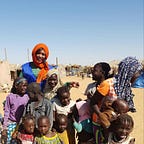Between conflict and climate change
The struggle of internally displaced persons in Timbuktu
It is an intense morning at the sub-office of the World Food Programme (WFP) in Timbuktu.
“We have to go! The displaced people of Hondoubomokoïna are waiting for us!” Exclaim my colleagues Zacharie and Bouya.
The region of Timbuktu is the sixth administrative region of Mali. Its capital is the city of Timbuktu, located 1,000 km northeast of the Mali’s capital, Bamako. Following the conflict that has affected the region since the 2012 crisis and the capture of the city by rebel and then jihadist movements, the food security situation of the inhabitants of the city remains worrying.
Some residents are forced to flee due to conflict or flooding, leaving behind all their belongings, and displacement is again becoming more common.
We hit the road towards the Niger River.
The contrast between the city of Timbuktu, surrounded by vast expanses of sand, and the vegetation of the banks of the river is surprising. As we arrive on the bank of the river, we are greeted by Mr Abouko Houssa, a Bozo living on the river that brings us aboard his pirogue — a small handcrafted boat used by traditional fishermen. Any means of transport is useful when saving lives!
“Look at these houses…people lived and farmed the land here. Our children played quietly, and we worked. Today the area is completely flooded and ruined,” explains Abouko.
After half an hour on the Niger River, we arrive at Hondoubomokoïna, located 19 km from the city of Timbuktu. There are 1,050 people waiting for us as we arrive. Between the worried faces of mothers and those of the fathers who are relieved as they see us arriving, I come to understand that the situation is critical.
Sitting in a tent, they await to receive much needed assistance. Our partner, the local non-governmental organisation — ADAZ, starts to distribute food coupons that people can trade for different types of food with local retailers.
Just after we arrive, a lady with a smile approaches me.
“Are you from WFP? I recognize your vest,” says Aminata Cisse “It is your colleagues who came to see us when we had nothing to eat, they had these same clothes,” adds the 40-year-old mother of six.
“I was pregnant when I had to flee my village with my children as a result of conflict, I was desperate because I could not to feed my children”.
“I lived in a village on the other side of the river for 20 years. Two months ago, armed bandits chased my community away, telling us that we were living on their land. They gave us two choices: flee leaving everything behind or stay and die,” she says with emotion as she tries to contain her tears.
As of January 2019, over 120,000 internally displaced persons have been recorded throughout Mali. Flooding in this area prompted the Government of Mali to call upon its humanitarian partners — including WFP — to meet their basic needs.
“The first assistance we received was in the form of food (cowpea, oil, salt, etc.), then WFP offered us the coupons. It suits me better because my daughters love spaghetti and rice; it’s the first thing I take when I go to the shop,” she exclaims, this time with visible relief.
“Despite my precarious situation today, I remain optimistic and I hope that one day the Government will help us to return home to our land. I could resume market gardening, live with dignity without any help and allow my children to go back to school. “
Thanks to the financial support of Luxembourg, Norway, USAID, Monaco, Canada, Japan, Spain, Germany, France, Switzerland, European Union, United Kingdom and UN CERF, WFP in Mali supports the Government reach the most vulnerable with emergency food distributions, saving lives along the way. This year, 683,655 people in the same situation as Aminata benefited from emergency and seasonal assistance.
